The tinfoil barb (Barbonymus schwanenfeldii) is a very large freshwater fish from Cyprinidae family. It can be up to 14 inches (35 cm) long. Quite often the juveniles are sold on the market and nobody tells about how large the fish becomes as an adult one and as a result, the fish quickly overgrows any tank of a common aquarist and then requires a really spacious tank.
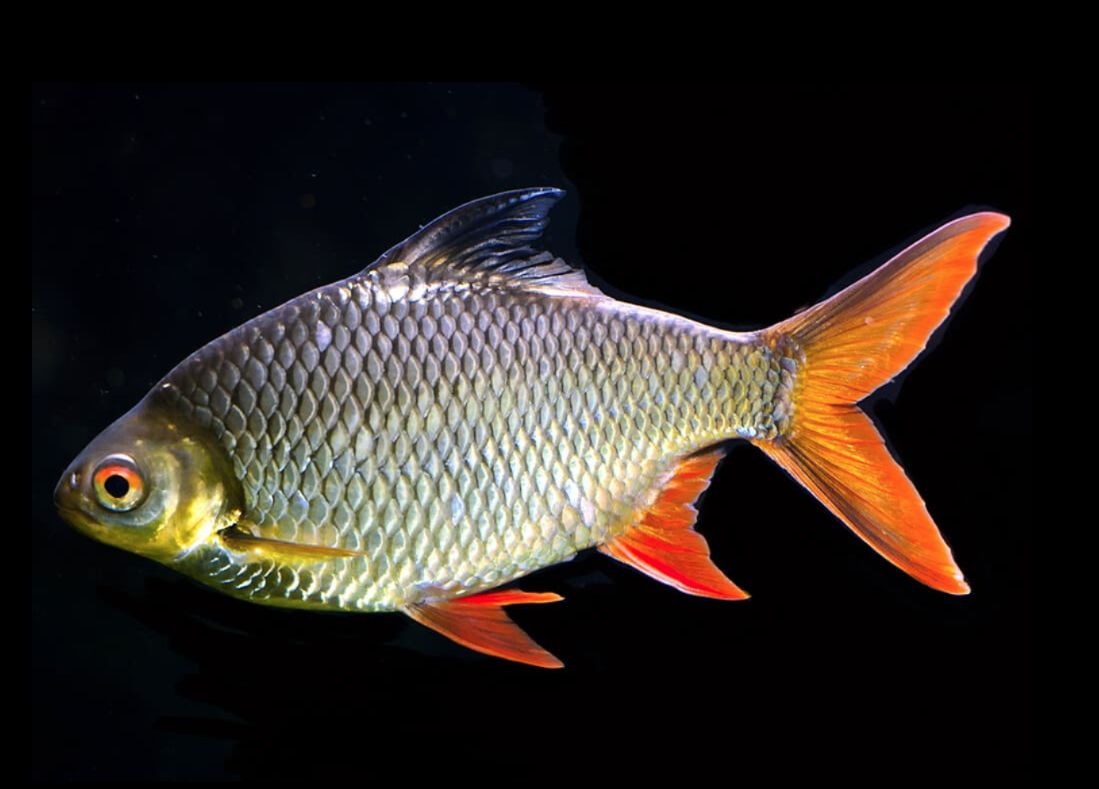
Contents
Habitat in the wild
The tinfoil barb (scientific name: Barbonymus schwanenfeldii) is a freshwater fish belonging to the family Cyprinidae, which is commonly known as the minnow or carp family. This family includes a wide variety of fish species that are often kept as aquarium pets or used for various purposes like food or sport fishing. Cyprinids are known for their diverse shapes, sizes, and behaviors.
Tinfoil Barbs are native to Southeast Asia, specifically found in river systems in countries such as Thailand, Malaysia, and Indonesia. They are popular choices for large aquariums due to their impressive size, unique appearance, and active behavior. These fish are characterized by their shiny silver scales and distinct red or orange fin markings.
The tinfoil barb is widespread over the whole territory of South-East Asia. It is also encountered in several large river systems including Mekong and Chao Phraya (source). The tinfoil barb dwells in large river channels with high water level, in bottomland coastal area as well as in flooded forests during rain season, where the fish goes to lay eggs.
As the water gets back to large rivers the fish returns there as well. In the wild feeds on algae, plants, insects, small fishes, carrion.
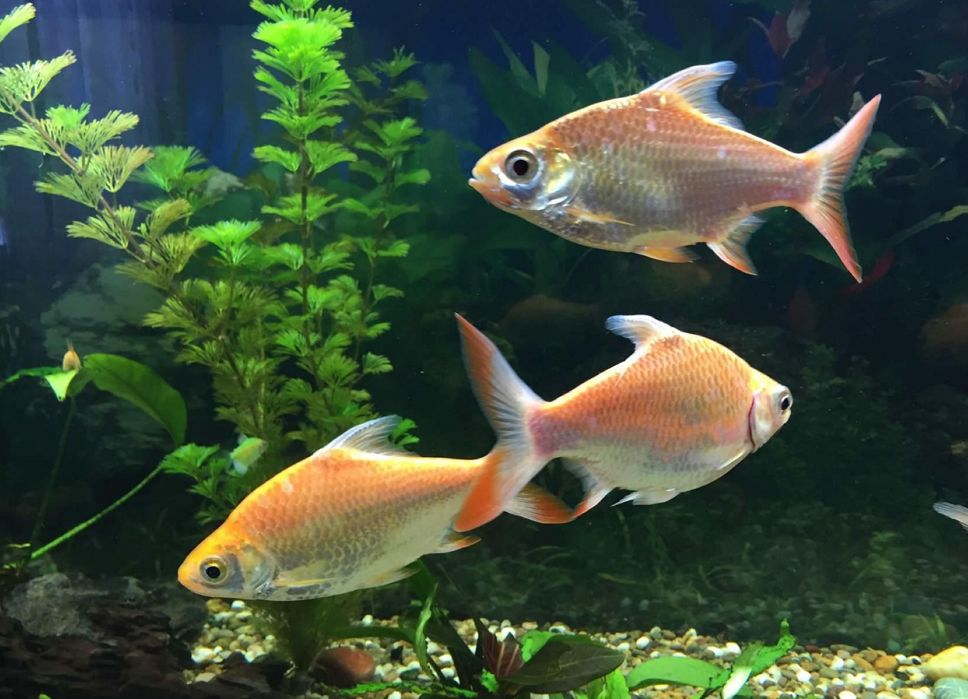
Description
Size
Tinfoil barbs are known to grow relatively large compared to many other aquarium fish. They can reach lengths of over 12 inches (30+ cm) in a well-maintained aquarium. However, it’s important to note that their growth rate and final size can be influenced by factors such as tank size, diet, water quality, and genetics.
Lifespan
Tinfoil barbs typically have a lifespan of around 8 to 10 years when kept in a well-maintained aquarium with proper care. Like many fish species, their lifespan can be influenced by various factors, including water quality, diet, tank size, genetics, and overall husbandry practices.
Body
The body color is silvery, sometimes with golden tint. They are known for their shiny silver scales that reflect light, giving them a metallic appearance. Their scales can sometimes appear iridescent under the right lighting conditions. The fins and tail are red with clearly seen lines of their edges.
Juvenile tinfoil barbs might have a more intense and contrasting coloration, including deeper red or orange fins. As they grow, their coloration can become more subdued.
There’s a variation called albino tinfoil barb or golden tinfoil barb, but it has no differences in care compared to the ordinary fish. As the name suggests, the Albino Tinfoil Barb exhibits an albino coloration, which is characterized by a lack of melanin pigment. This results in a pale or white appearance with pink or reddish eyes. The other distinguishing features of the albino tinfoil barb are similar to those of the standard tinfoil barb.
| Characteristic | Description |
|---|---|
| Scientific Name | Barbonymus schwanenfeldii |
| Common Name | Tinfoil Barb |
| Family | Cyprinidae (Minnow or Carp family) |
| Origin | Southeast Asia (Thailand, Malaysia, Indonesia) |
| Size | Can grow over 12 inches (30+ cm) |
| Color | Shiny silver scales with distinct red/orange fins |
| Behavior | Active and schooling fish |
| Tank Size | Requires a large tank due to its size |
| Aquarium Conditions | Tropical freshwater; adequate filtration and water flow |
| Diet | Omnivorous; eats plants, insects, and small organisms |
| Compatibility | Generally peaceful, but can be fin nippers |
| Lifespan | 8-10 years with proper care |
| Special Considerations | Jumpers, provide plenty of swimming space |
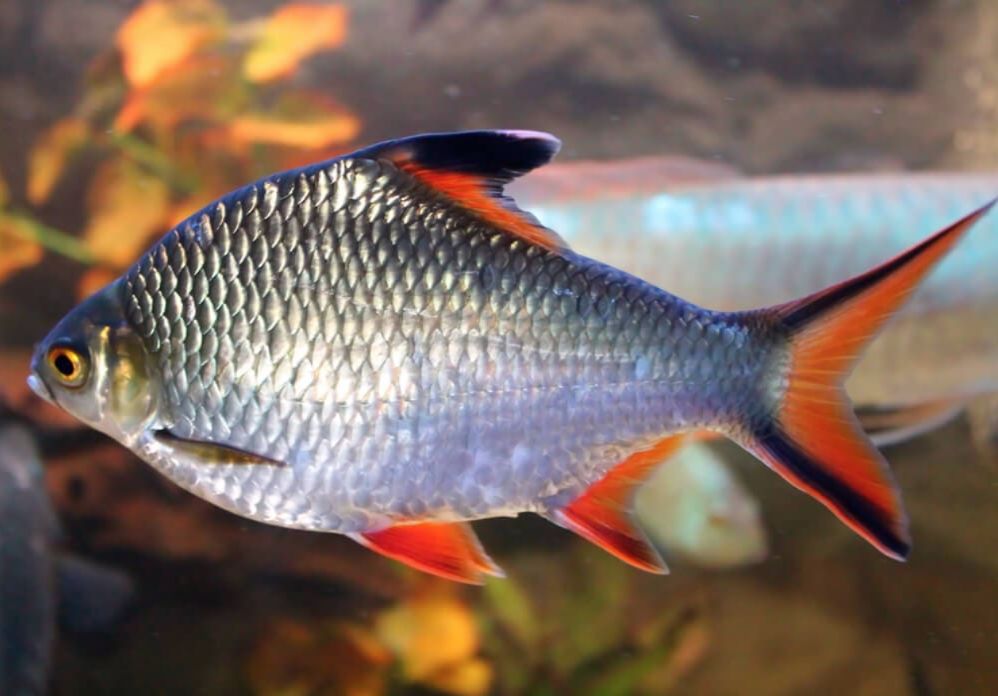
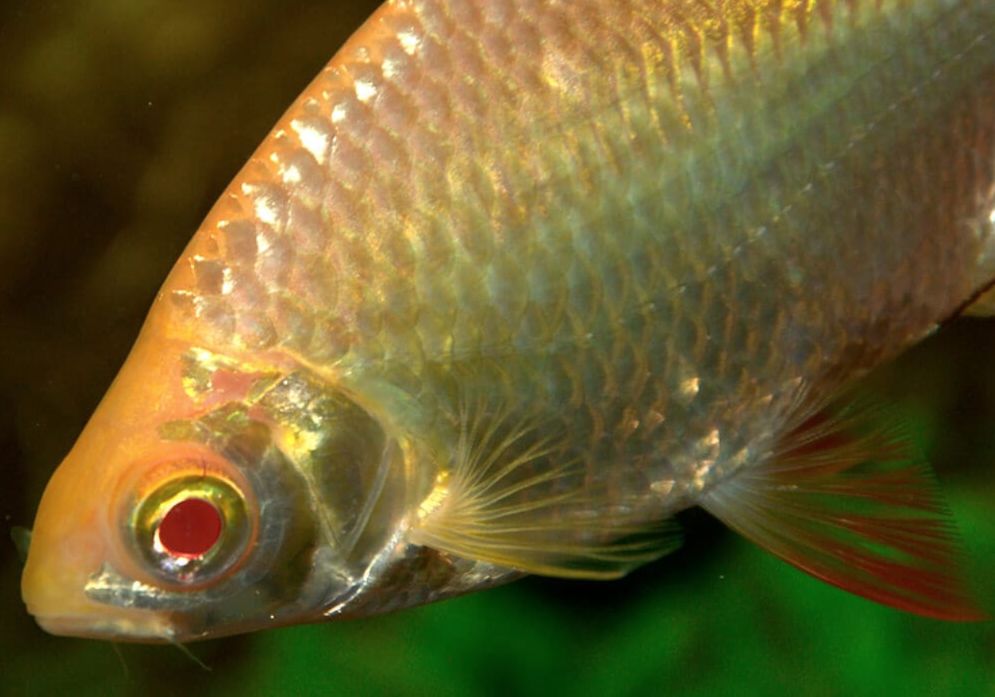
Difficulties in keeping
The tinfoil barb is quite undemanding and easy to keep. It will eat everything you give, doesn’t require any special tank conditions, but the only drawback is that it grows very fast. Since you have to keep tinfoil barb species in a very roomy tank, there are not so many aquarists who will be able to do this, especially the beginners.
Due to its silvery coloring and tendency to stay in a school the tinfoil barb draws the eye and that’s why these species are used mainly in commercial business. The tinfoil barb is hardly ever seen in home aquaria. As the rule schools are kept in tanks located in some public places (large offices, shopping malls etc.).
Though as a rule barb demonstrates quite peaceful attitude towards large fishes, it eagerly feeds on smaller ones, which makes the fish completely unsuitable for community tanks.
Care and keeping in a tank
Tan size
Keeping such large fish is quite a troublesome and expensive thing to do, that’s why they are quite seldom seen in home aquaria, though in general tinfoil barb is very undemanding.
Tinfoil barbs (Barbonymus schwanenfeldii) are relatively large and active fish, so they require a spacious aquarium to thrive and exhibit their natural behaviors. The recommended tank size for tinfoil barbs depends on their size, the number of fish you plan to keep, and whether you intend to house them with other fish species.
Here are some general guidelines:
- Minimum Tank Size: For a single adult tinfoil barb, a tank size of at least 75 gallons (approximately 283 liters) is recommended. However, considering their potential size and active nature, a larger tank is even better.
- Group Size: Tinfoil barbs are social fish and prefer to be kept in groups. If you’re keeping a group of them, you’ll need a larger tank. Aim for a tank that is at least 125 gallons (473 liters) for a small group of tinfoil barbs.
- Tank Dimensions: In addition to the volume of water, consider the dimensions of the tank. Tinfoil barbs are strong swimmers, so a tank with sufficient horizontal swimming space is important. A tank that is longer rather than taller is preferable.
Tank decor
You can decorate the tank any way you like, the tinfoil barb will feel comfortable even in a completely empty tank. However, if you can afford getting a tank of 125 gallons capacity and more, it’s not reasonable to save money on decorations. Simulation of real river bed appears as the most natural way of tank decoration. The bottom substrate is stony with several large smooth stones, the background view should resemble a real river shore with snags. Though live tank plants are good as tank decorations, in this case they will be quickly destroyed.
Water parameters
Optimal tank water parameters are the following:
- Temperature: Tinfoil barbs prefer a tropical environment with a water temperature between 72°F to 82°F (22°C to 28°C). Keeping the temperature within this range will ensure their metabolic processes function optimally.
- pH Level: Tinfoil Barbs can tolerate a pH range of 6.5 to 7.5, but they generally thrive in slightly acidic to neutral conditions. Aim for a pH around 7.0 for optimal health.
- Water Hardness: These fish are adaptable to a range of water hardness levels, but a general guideline is to keep the water moderately hard, around 5 to 12 dGH.
- Ammonia and Nitrite: Both ammonia and nitrite should be maintained at zero. These compounds are toxic to fish and can lead to stress and health issues if present in the water.
- Nitrate Levels: Nitrate is a less toxic byproduct of the nitrogen cycle, but elevated levels can still be harmful. Aim to keep nitrate levels below 20-40 ppm through regular water changes.
- Water Quality: However, the tinfoil barb has far more strict requirements to tank water quality. Since tinfoil barb habitat is in clean oxygen-rich lotic waters, it can’t stand any organic waste accumulation in water. Water in a tank has to be crystal clean. Tank maintenance is limited to weekly water renew (15–20% from the total tank volume). The fresh water has to have the same pH, dGH and temperature as well as regular bottom substrate cleaning and removing organic waste should be performed.
- Filtration and Aeration: Tank water filtration system is of crucial significance in this case. It should consist at least of two filters that work in tandem or, if the capacity allows, duplicate each other in case if one turns off or breaks down. Providing efficient filtration and aeration helps maintain oxygen levels and keeps the water clean. Tinfoil barbs are active swimmers and produce waste, so proper filtration is important.
Always ensure that any changes in water parameters are gradual, as sudden shifts can stress the fish. Regular water testing using reliable test kits will help you monitor and maintain the appropriate water conditions for your Tinfoil Barbs.
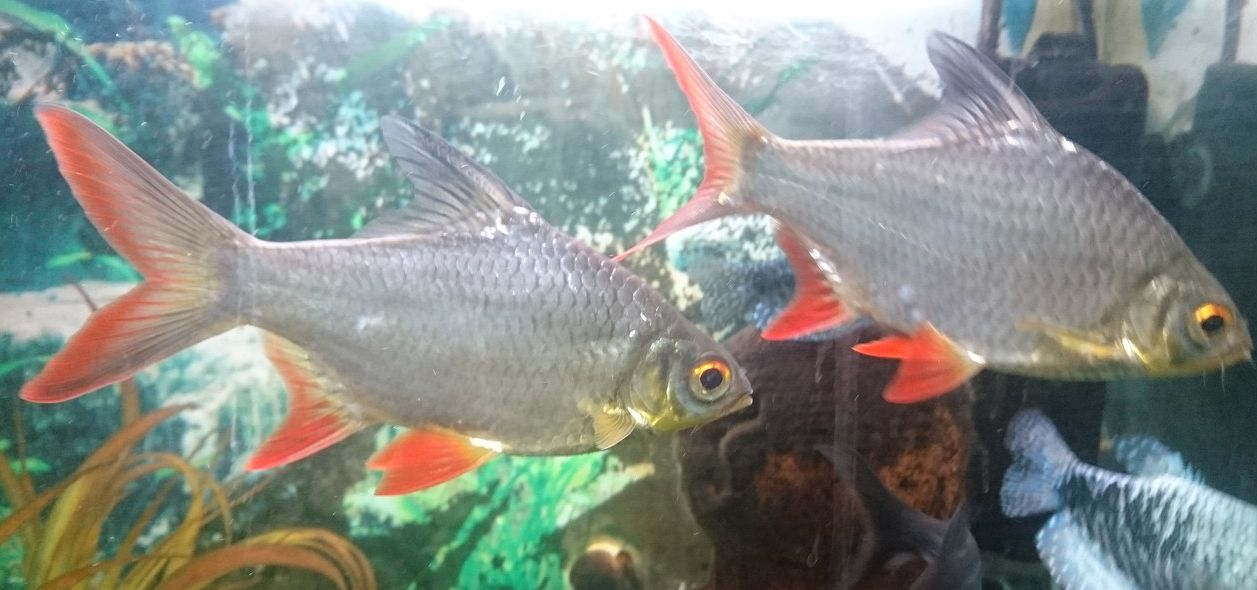
Diet
Tinfoil barbs are omnivorous fish that have a diverse diet in the wild. To keep them healthy and vibrant in an aquarium, it’s important to provide a balanced diet that includes both plant-based and protein-rich foods.
Here’s a breakdown of their diet:
- Plant Matter: Tinfoil barbs naturally consume various types of plant matter in the wild. You can provide them with a variety of plant-based foods, including:
- High-quality flake or pellet foods with plant-based ingredients
- Blanched vegetables like spinach, zucchini, and peas (remove the skin and seeds). It will eagerly feed on cucumber, spinach, lettuce and other vegetables and fruit.
- Spirulina-based foods, which are rich in vegetable matter
- Protein: In addition to plant matter, tinfoil barbs also need a source of protein to meet their dietary needs. Offer them:
- High-quality pellets or flakes designed for omnivorous fish
- Frozen or live foods like brine shrimp, bloodworms, daphnia, and mosquito larvae
- Occasionally, you can provide them with small amounts of high-quality fish or shrimp as a treat
- Variety: Providing a varied diet is essential to ensure your tinfoil barbs receive all the necessary nutrients. Rotate between different types of foods to mimic their natural feeding habits and to prevent nutritional deficiencies.
- Frequency: Feed the tinfoil barb 2-3 times a day with amount of food that it can eat in 5 minutes. It is important not to overfeed your pets, since it is a gluttonous fish and it doesn’t have sense of fullness, which may cause digestion problems.
- Observation: Pay attention to their behavior and appetite. If they are not consuming food as usual, it could be a sign of health issues or water quality problems.
Remember that the dietary requirements of fish can vary slightly based on individual preferences and health conditions. Always adjust their diet based on their response and consult with experienced fishkeepers or aquatic professionals if you’re unsure about their nutritional needs.

Tank mates
Are tinfoil barbs aggressive? In general this fish species isn’t aggressive, but at that it treats all smaller sized tank mates as food. You shouldn’t keep it with slow fishes (like goldfish or koi) since tinfoil barb activeness can make goldfish stressed.
The best tank mates are not aggressive fish species – angelfish, silver dollar, arowana, bala shark, fire eel, clown loach. Can tinfoil barbs live with oscars? Fish are able to live in spacious aquariums with quite aggressive cichlids: oscar fish, jaguar cichlid, parrot fish, even flowerhorn.
In the wild tinfoil barb swims in large schools. Therefore you should keep a school of at least 5 species in a tank. If the tinfoil barb doesn’t have a company of its kind it quite often starts to demonstrate aggression or vice versa timidity.
Gender differences: male vs female
There are almost no differences between the males and females appearance. Only during their spawning period you may recognize the female due to its rounded abdomen with eggs.
The most reliable method for determining the sex of tinfoil barbs is through their behavior during the breeding season. During spawning, males and females exhibit specific behaviors that can help you differentiate them:
- Breeding Behavior: Male tinfoil barbs often display more intense coloration and may develop small tubercles (small, hard, raised areas) on their heads and pectoral fins. Males will chase and court females, displaying more active and aggressive behavior during the breeding period.
- Egg-Laying Behavior: Female tinfoil barbs are responsible for laying eggs. When a female is ready to lay eggs, her belly might appear slightly swollen. During the breeding process, females will release eggs, and males will fertilize them.
However, accurately identifying the sex of tinfoil barbs without observing their breeding behavior can be challenging, and in most cases, it’s difficult to tell them apart based solely on their physical characteristics. If you’re interested in breeding tinfoil barbs, observing their behaviors during spawning is the most effective method for sex identification.
Breeding
Mating season starts when environmental conditions change due to the beginning of rain season and further migration of the tinfoil barb to flooded areas of tropical forests.
This kind of behavior is source of problems when breeding in a home aquarium, since it requires huge storage capacities with water that has variable parameters. The tinfoil barb you see on sale as a rule were either caught in the wild or bred in special hatcheries by means of hormone injections.